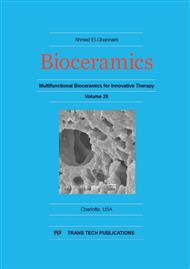[1]
P. Yáñez-Sedeño, J.M. Pingarrón, Gold nanoparticle-based electrochemical biosensors, Anal. Bioanal. Chem. 382 (2005) 884–886.
DOI: 10.1007/s00216-005-3221-5
Google Scholar
[2]
B. Liu, J. Liu, DNA adsorption by indium tin oxide nanoparticles, Langmuir 31 (2015) 371–377.
DOI: 10.1021/la503917j
Google Scholar
[3]
N. Sun, C. Deng, Y. Liu, X. Zhao, Y. Tang, R. Liu, Q. Xia, W. Yan, G. Ge, Optimization of influencing factors of nucleic acid adsorption onto silica-coated magnetic particles: Application to viral nucleic acid extraction from serum, J. Chromatogr. A 1325 (2014).
DOI: 10.1016/j.chroma.2013.11.059
Google Scholar
[4]
I. Roy, T.Y. Ohulchanskyy, D.J. Bharali, H.E. Pudavar, R.A. Mistretta, N. Kaur and P.N. Prasad, Optical tracking of organically modified silica nanoparticles as DNA carriers: A nonviral nanomedicine approach for gene delivery, Proc. Natl. Acad. Sci. U.S.A. 102 (2005).
DOI: 10.1073/pnas.0408039101
Google Scholar
[5]
L. Vigderman, E.R. Zubarev, Therapeutic platforms based on gold nanoparticles and their covalent conjugates with drug molecules, Adv. Drug Deliv. Rev. 65 (2013) 663–676.
DOI: 10.1016/j.addr.2012.05.004
Google Scholar
[6]
F. Gao, P. Botella, A. Corma, J. Blesa, L. Domg, Monodispersed mesoporous silica nanoparticles with very large pores for enhanced adsorption and release of DNA, J. Phys. Chem. B 113 (2009) 1796–1804.
DOI: 10.1021/jp807956r
Google Scholar
[7]
Z. Wu, D. Zhao, Ordered mesoporous materials as adsorbents, Chem. Commun. 47 (2011) 3332–3338.
Google Scholar
[8]
Y. Masuda, S. Kugimiya, K. Murai, A. Hayashi, K. Kato, Enhancement of activity and stability of the formaldehyde dehydrogenase by immobilizing onto phenyl-functionalized mesoporous silica, Colloids Surf. B: Biointerfaces 101 (2013) 26–33.
DOI: 10.1016/j.colsurfb.2012.05.037
Google Scholar
[9]
K. Nakanishi, M. Tomita, H. Nakamura, K. Kato, Specific binding of immunoglobulin G to protein A-mesoporous silica composites for affinity column chromatography, J. Mater. Chem. B 1 (2013) 6321–6328.
DOI: 10.1039/c3tb20998a
Google Scholar
[10]
R. Hikosaka, F. Nagata, M. Tomita, K. Kato, Adsorption and desorption characteristics of DNA onto the surface of amino functional mesoporous silica with various particle morphologies, Colloids Surf. B: Biointerfaces 140 (2016) 262–268.
DOI: 10.1016/j.colsurfb.2015.12.054
Google Scholar
[11]
J.L. Steinbacher, C.C. Landry, Adsorption and release of siRNA from porous silica, Langmuir 30 (2014) 4396–4405.
DOI: 10.1021/la402850m
Google Scholar


